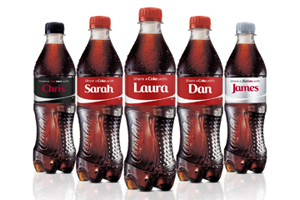Redacción Alabrent
In December 2013, international analyst Smithers Pira (www.smitherspira.com) forecast an annual growth of 2 per cent for the print industry through until 2018. This growth is expected to be driven by growth in transitional economies, as well as added-value opportunities. The key lies in turning print into something more than just ink on a piece of paper and instead developing applications where the printed ‘product’ itself is truly valuable.Some of the high-profile examples of this include the evolution of fields such as printed electronics, 3D printing and of course, cross media. Yet it’s not only these areas of technological innovation that are creating valuable print applications; sometimes it can be a creative use of well-established technologies that turns print from something disposable into a must-keep item.
One high-profile example of creativity giving rise to a valuable printed ‘product’ is the bottle labels in Coca-Cola’s 2013 ‘Share a Coke’ campaign. In the campaign, which originated in Australia before expanding to become the company’s largest ever global promotion, the soft drinks giant replaced its label with 250 of the most common first names from around the world[2] in multiple different languages. This enabled customers to ‘share a coke’ with friends and family and has evolved into multiple campaign activations such as a summer tour in a number of different countries and a Christmas social media campaign. The campaign has achieved enormous success for the brand, which has seen both sales and social media engagement with the brand increase.
For the most part, bottle labels were printed in two stages: first using conventional label printing for between 75 to 90 per cent of the design, and then digital print to enable the printing of variable names. In some activations, a specially developed can-printing technique enabled simultaneous printing of eight or twelve different names.
Gregory Bentley, European packaging innovator, Coca-Cola Services SA, says: “Different activations around the world saw variation being done in different ways. For example, production in Germany is of refillable PET bottles with wash-off paper labels, so we didn’t actually need to use digital printing for the labels that were on shelf because labels could be mixed to gain the variation in names. We enabled true ‘personalisation’ there by making it possible for customers to go online and order a bottle with a particular name on; these orders were fulfilled using digital print.”
“The thing about the campaign is that, from a technical perspective, the labels aren’t actually ‘personalised’ per se,” he continues. “Our role was using digital print as an enabler for variable print and printing a selection of names so that consumers could do the personalisation themselves by finding a name on shelf and giving that bottle to someone or even buying it for themselves.”
Bentley’s comments highlight the importance of creative thinking in developing truly valuable print applications that harness the capabilities of print technology to deliver a ‘product’ that makes the most of print’s benefits.
Exploiting the unique benefits of print – such as the physical and tangible – is another way in which print service providers are able to differentiate themselves by using print to do things that are not possible with electronic communications.
The social stationery arena – such as wedding invitations, change of address cards and thank you notes – provides a range of good examples where print is the value. Wedding invitations, which are designed as much to be keepsakes as they are for their actual function, offer a wealth of creative examples. From digitally printed passport-themed invitations for destination weddings through to bespoke laser-cut stationery suites, many wedding stationery printers’ websites read like a veritable glossary of different print technologies.
Print’s tangible, hold-it-in-your-hands quality is also being used to produce valuable products in the form of brochures for luxury brands, art galleries, auction houses and property developers, and the photo merchandise market is cashing in on print’s physical qualities too.
High margin printed products such as photobooks and personalised greetings cards are growing in popularity among casual and hobbyist photographers. 2013 research conducted in the USA by international industry analyst InfoTrends found that 32 per cent of snapshot photographers, 45 per cent of family memory-keeper photographers, 57 per cent of hobbyist photographers and 71 per cent of advanced hobbyist photographers had ordered some kind of photo merchandise in the preceding year. With more than 20 per cent of European camera owners (including smartphone users) indicating an intention to order a photobook (or photobooks) in the future, photo merchandise is clearly a big growth opportunity internationally.
Moving on from the creative and the tangible, another technique being used increasingly to create valuable printed pieces is the physical integration of print with digital technologies using cross media.
One example of this can be seen in technologies such as Americhip™ and TV in a Card, which are pushing the boundaries of what is possible in print with applications – from the first Video in Print® advertisement in US Entertainment Weekly in 2009 through to greetings cards featuring video in 2011 and the Microsoft Office 365 magazine advertisement that turned an issue of Forbes into a Wi-Fi hotspot in 2013.
Russell Lawley-Gibbs, Inventor and CEO of TV in a Card says: “What our customers find so appealing is the power to combine the most powerful communications medium – video – with the precision targeting that is possible in printed direct marketing. It means that they can target hard-to-reach customers with specific messages and make sure that their videos are viewed by the people that they want to see them. Additionally, because the combination of video and print has such impact, we’ve found that their messages often ‘go viral’ as recipients share the piece with friends, family, peers and colleagues.”
Cross media technologies such as QR codes are also being used in product packaging and retail displays with increasing frequency. Certainly research published in 2012 by internet behaviour analyst ComScore found that of the 14.2 million smartphone users in France, Germany, Italy, Spain and the UK who scanned a QR code in a three-month period, 38 per cent scanned a QR code printed on product packaging. The growing popularity of interactive packaging is largely being driven by growth in online shopping, because as consumers become more accustomed to looking for additional production information, discount vouchers and discounts, they are increasingly looking to packaging for more information.
QR codes aren’t the only technologies being used to bring packaging to life – augmented reality (AR) and near field communication (NFC) are growing in prominence in both packaging and in-store displays as marketers seek to create an immersive retail experience.
Creative thinking paired with technological innovation is transforming the print industry. This is why the organisers of Ipex 2014 are focused on providing visitors with opportunities to learn more about how they can use new trends to grow their businesses. From Future Innovations and the Inspiration Avenue, through to the co-located Cross Media Production and World Print Summit, as well as a series of Masterclasses, Ipex will be abuzz with new ideas.
Future Innovations at Ipex will provide print service providers with a unique opportunity to find out in one place what is happening in the industry now and what areas have high growth potential for the next few years. Focused on areas such as 3D printing, printed electronics, digital print on packaging and photo applications, Future Innovations is aimed at providing insight into how applications are created and the solutions used in the production process, as well as providing inspiration.
Meanwhile Inspiration Avenue will showcase and celebrate the power and versatility of print via a large range of impact statements, fascinating facts, growth opportunities and signposting for visitors. Co-located with Ipex, Cross Media Production will enable print providers, publishers, agencies and brand owners with an opportunity to ‘get under the hood’ of building, managing and delivering cross media campaigns.
Taking place from 24th to 29th March 2014 at the ExCeL London, Ipex 2014 and Cross Media Production will boast 130 content sessions and a wealth of opportunities to learn about ways print can create value. More information about the event and registration details are available at www.ipex.org and www.cmpshow.com



